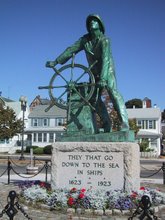For the past few days, I've been thinking about Eddie Rickenbacker. For anyone who doesn't remember him, Rickenbacker was the most successful American ace of WWI, and he survived the war, which most of them didn't. He was one of the most popular American heroes of the War to End Wars.
Rickenbacker had actually been famous as a racing-car driver before the war, and was for a time General Pershing's chauffeur. After the war, he decided to enter the automobile industry. Capitalizing on his name, the started manufacturing a car called the Rickenbacker (a name that's no stranger than Chrysler and less so than Chevrolet, which is not pronounced the way it's spelled). The advanced feature for which the Rickenbacker was remembered was--get this--four-wheel brakes. That's right--brakes on all four wheels. Up to this time, most American cars had had brakes only on the rear wheels.
Although there were a number of other independent manufacturers, with its founder's heroic reputation the Rickenbacker presented a particular threaten the dominance of Ford and GM in the American market. (Chrysler wasn't formed until a couple of years after Rickenbacker started making cars.) What did they do? Did they put their engineers to work to leapfrog the competitor's technology? Did they at least match that technology and offer lower prices to meet the competition? No, and no. They started a smear campaign, centering around allegations that four-wheel brakes were dangerous. The Rickenbacker lasted only a few years.
This story is all too emblematic of the way in which the US automobile industry has operated for the past hundred years. While American manufacturers have often trumpeted this or that new device, their products have been technologically inferior to European and later Japanese vehicles.
For more than a decade we have heard that American buyers want big, gas-guzzling trucks and SUVs. There has been some truth to this, but little recognition that a large part of that desire was created by marketing. If Detroit had wanted to sell smaller and more efficient automobiles, more of them would have been sold.
So, what to do with an industry that has had a death wish for decades and is now in extremis? I opposed the Chrysler bailout on ideological grounds; as a matter of economics, it worked out well. Now the economic argument is much stronger than it was when only one American company--and the smallest--was in trouble.
Although I'm not comfortable agreeing with the leaders of GM, Ford and Chrysler, I must concede that their argument that no one will buy a car from a bankrupt company has a lot of force. Yet it's anything but clear that Congress will pass a bailout bill for American car-makers, even if they last through January 20th.
Something else is needed. I suggest a federal receivership, which would be like a bankruptcy, except that it would be funded by the federal government and would be intended to a reconstruction--indeed, reinvention--of the industry.
As part of this reinvention the companies' management should be decapitated. To make the radical change in direction that the industry needs, the top 50 no, make that 100 executives should be shown the door. Replacements should be brought in from Toyota, Honda, VW, etc., and from other industries such as solar and wind power. (Part of the plan should be to diversify the companies into new technologies.)
In true crisis mode, a rescue of the auto industry will have to be made up on the fly. Even if Congress adopts a receivership, getting the companies back to financial stability, much less prosperity. But the cost of letting the companies be liquidated makes the risk worth it.
Subscribe to:
Post Comments (Atom)

No comments:
Post a Comment